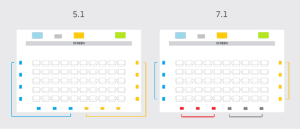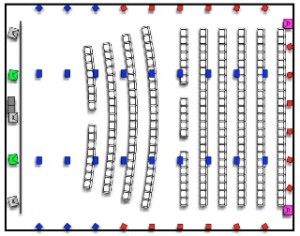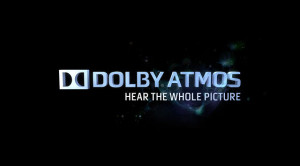Dolby Atmos Review: The Pinnacle of Cinematic Sound Engineering?
Ok so Dolby Atmos may have come into existence back in 2012 with Disney’s Brave, but now that it is starting to roll out into an increasing number of public theatres and more and more movie makers are electing to use Atmos sound, let’s take a look at what all the fuss is about. Does it really enhance the cinema experience that much? Can it revive the declining commercial cinema business? We like to think so…
Let’s start by explaining what exactly is revolutionary about Dolby Atmos technology for anyone who is not familiar. Most cinemas currently have either 5.1 or 7.1 surround sound systems with a maximum of 8 individual tracks that are then projected from a varying number of speakers positioned around the cinema.  The diagram (right) is colour coordinated to demonstrate how the different channels would be directed. For example, with 7.1 surround sound, you get three channels up front (left, right and centre) two side surround channels (left and right), two rear channels (left and right) and one subwoofer channel.
The diagram (right) is colour coordinated to demonstrate how the different channels would be directed. For example, with 7.1 surround sound, you get three channels up front (left, right and centre) two side surround channels (left and right), two rear channels (left and right) and one subwoofer channel.
This was all very well and good back when surround sound came into cinemas and we were impressed with the relatively immersive sound experience. Until now that is. Dolby Atmos has taken this immersive idea to a whole new level. Remember how 5.1 and 7.1 systems can have up to 8 tracks? Well, Dolby Atmos is capable of processing up to 128, meaning more detail and more definition. It’s hard to describe quite what an improvement this is. Imagine being able to individually record every single orchestral instrument for a movie’s soundtrack and have them all played at once, with equal audio quality. Not a great analogy but you get the idea. The most notable difference they have made, however, is the configuration of the speakers in the auditorium. Instead of just having them up front and at the sides, Atmos uses up to 64 speakers and places them all around the auditorium – including overhead. Take a look at the diagram below to get a better idea.

What does this mean for audiences? Well, for one thing it means you are able to experience true overhead sound instead of the simulated experience you would get with previous technology. Directors can design the soundtrack of their movies to recreate the 360 degree sound characters experience on screen, by steering these different tracks around the specific individual speakers. The sound location is more natural and life-like and corresponds precisely with what is happening on-screen. Each speaker is individually addressable, allowing for precise sound placement anywhere within the auditorium and giving an extremely powerful sense of motion when the sound moves around the screen. If a dinosaur was stalking a character and moving from left to right behind him, then the sound would pan from specific left to right speakers at the back of the screen, whereas previously all the left speakers would have played the sound before all the right ones did, front and back. If a character runs under a waterfall, the sound of the rushing water will move from all the front speakers in the theatre to the back ones, including the overheads. These are just examples pulled from my limited creative brain to give you an idea. But hopefully, they convey the basic principle.
So how does it sound? Well, I went to see The Hobbit: The Desolation of Smaug in a VueXtreme screen, one of the few sites to actually have Dolby Atmos installed in the UK and as soon as I heard the MGM lion roar, I was already excited. What followed was a completely enhanced cinema experience. The world of J.R.R. Tolkein was brought to life in a way like I had never experienced before. Whilst the entire film didn’t fully exploit the capabilities of Dolby Atmos (probably due to continuing experimentation with the new technology), the scenes in which it did, particularly with the dragon, were immensely impressive and it must have been simultaneously fun and challenging to create. The way Smaug slithered round the humongous cavern throughout his exchange with Bilbo was equally intimidating to Bilbo AND the audience as his sinister voice moved unnervingly around the theatre with a clarity that caused members of the audience to spontaneously look to see where this sound was coming from. It was visceral. Even the tumbling coins and various artefacts Bilbo tripped over on the mountains of gold treasure caused a ripple effect around the theatre, as they did in the story space on screen. Just breath-taking.

So is Dolby Atmos really an experience worth investing in? Let’s remember that you’re going to be charged a premium ticket price to see a film that uses Dolby Atmos, usually with the latest digital projection technology as well to create the best possible movie-going experience. In this film fan’s opinion, yes! When you’re seeing a large scale picture like The Hobbit, the extra price tag is more than worth it. Seeing a movie in the cinemas is about being submerged in the story being told on the big screen, aligning our perspective with those of the characters and Dolby Atmos does this better than any 7.1 sound system, as it places you in the middle of the action with a level of realism and verisimilitude that has never been achieved before. It’s hard to imagine sound getting much better than this, although I’m sure the next big thing is already on the way.
How does it compare to Imax? Well, they still use 7.1 sound systems and so, whilst they might provide the perfect visual immersive experience and fairly high-quality audio equipment, the audio experience will never match that of Dolby Atmos screens. I’m sure they have some equivalent on the way but with VueXtreme using the latest 4k projectors and Dolby Atmos sound systems, it seems the wise choice for cinema-goers looking for the fully inclusive high-quality package from their cinema.
If you’re looking for more in-depth and technical info on Dolby Atmos, check out the Dolby website where there are tonnes of interesting facts and informative videos. Meanwhile, leave your thoughts and comments below!


